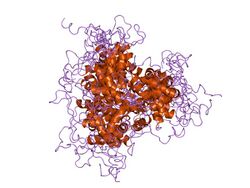Biology:Fork head domain
| Fork head domain | |||||||||||
|---|---|---|---|---|---|---|---|---|---|---|---|
 Structure of the winged helix protein Genesis.[1] | |||||||||||
| Identifiers | |||||||||||
| Symbol | Fork_head | ||||||||||
| Pfam | PF00250 | ||||||||||
| InterPro | IPR001766 | ||||||||||
| SMART | SM00339 | ||||||||||
| PROSITE | PDOC00564 | ||||||||||
| SCOP2 | 2hfh / SCOPe / SUPFAM | ||||||||||
| CDD | cd00059 | ||||||||||
| |||||||||||
The fork head domain is a type of protein domain that is often found in transcription factors and whose purpose is to bind DNA.[2]
Function
The fork head protein of Drosophila melanogaster, a transcription factor that promotes terminal rather than segmental development, contains neither homeodomains nor zinc-fingers characteristic of other transcription factors.[3] Instead, it contains a distinct type of DNA-binding region, containing around 100 amino acids, which has since been identified in a number of transcription factors (including D. melanogaster FD1-5, mammalian HNF3, human HTLF, Saccharomyces cerevisiae HCM1, etc.). This is referred to as the fork head domain but is also known as a "winged helix".[3][4][5] The fork head domain binds B-DNA as a monomer,[4] but shows no similarity to previously identified DNA-binding motifs. Although the domain is found in several different transcription factors, a common function is their involvement in early developmental decisions of cell fates during embryogenesis.[5] Members of the class O of forkhead box transcription factors (FoxO) have important roles in metabolism, cellular proliferation, stress tolerance and probably lifespan.[6]
See also
References
- ↑ "Structural changes in the region directly adjacent to the DNA-binding helix highlight a possible mechanism to explain the observed changes in the sequence-specific binding of winged helix proteins". J. Mol. Biol. 278 (2): 293–9. May 1998. doi:10.1006/jmbi.1998.1703. PMID 9571051.
- ↑ "Five years on the wings of fork head". Mech. Dev. 57 (1): 3–20. June 1996. doi:10.1016/0925-4773(96)00539-4. PMID 8817449.
- ↑ 3.0 3.1 "The homeotic gene fork head encodes a nuclear protein and is expressed in the terminal regions of the Drosophila embryo". Cell 57 (4): 645–58. May 1989. doi:10.1016/0092-8674(89)90133-5. PMID 2566386.
- ↑ 4.0 4.1 "Co-crystal structure of the HNF-3/fork head DNA-recognition motif resembles histone H5". Nature 364 (6436): 412–20. July 1993. doi:10.1038/364412a0. PMID 8332212.
- ↑ 5.0 5.1 "Developmentally regulated Drosophila gene family encoding the fork head domain". Proc. Natl. Acad. Sci. U.S.A. 89 (18): 8754–8. September 1992. doi:10.1073/pnas.89.18.8754. PMID 1356269.
- ↑ "Stressing the role of FoxO proteins in lifespan and disease". Nature Reviews Molecular Cell Biology 8 (6): 440–50. June 2007. doi:10.1038/nrm2190. PMID 17522590.
de:Forkhead-Box
 |

